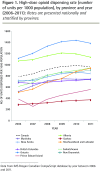Trends in high-dose opioid prescribing in Canada
- PMID: 25217680
- PMCID: PMC4162700
Trends in high-dose opioid prescribing in Canada
Abstract
Objective: To describe trends in rates of prescribing of high-dose opioid formulations and variations in opioid product selection across Canada.
Design: Population-based, cross-sectional study.
Setting: Canada.
Participants: Retail pharmacies dispensing opioids between January 1, 2006, and December 31, 2011.
Main outcome measures: Opioid dispensing rates, reported as the number of units dispensed per 1000 population, stratified by province and opioid type.
Results: The rate of dispensing high-dose opioid formulations increased 23.0%, from 781 units per 1000 population in 2006 to 961 units per 1000 population in 2011. Although these rates remained relatively stable in Alberta (6.3% increase) and British Columbia (8.4% increase), rates in Newfoundland and Labrador (84.7% increase) and Saskatchewan (54.0% increase) rose substantially. Ontario exhibited the highest annual rate of high-dose oxycodone and fentanyl dispensing (756 tablets and 112 patches per 1000 population, respectively), while Alberta's rate of high-dose morphine dispensing was the highest in Canada (347 units per 1000 population). Two of the highest rates of high-dose hydromorphone dispensing were found in Saskatchewan and Nova Scotia (258 and 369 units per 1000 population, respectively). Conversely, Quebec had the lowest rate of high-dose oxycodone and morphine dispensing (98 and 53 units per 1000 population, respectively).
Conclusion: We found marked interprovincial variation in the dispensing of high-dose opioid formulations in Canada, emphasizing the need to understand the reasons for these differences, and to consider developing a national strategy to address opioid prescribing.
Objectif: Décrire les tendances dans les taux de prescription de fortes doses d’opiacés et les variations dans le choix des différents opiacés au Canada.
Type d’étude: Étude transversale de type démographique.
Contexte: Le Canada.
Participants: Des pharmacies au détail qui distribuaient des opiacés entre le 1er janvier 2006 et le 31 décembre 2011.
Principaux paramètres à l’étude: Les taux de distribution d’opiacés, tels qu’établis d’après le nombre d’unités distribuées par 1000 de population, avec leur répartition par province et par type d’opiacé.
Résultats: Les taux de distribution de formules d’opiacés à des doses élevées a augmenté de 23,0 %, passant de 781 unités par 1 000 de population en 2006 à 961 unités par 1 000 de population en 2011. Alors que ces taux demeuraient stables en Alberta (6,3 % d’augmentation) et en Colombie-Britannique (8,4 % d’augmentation), ils augmentaient de façon importante à Terre-Neuve-Labrador (84,7 % d’augmentation) et en Saskatchewan (54,0 % d’augmentation). C’est en Ontario qu’on observait le plus haut taux annuel de distribution d’oxycodone et de fentanyl en fortes doses (756 comprimés et 112 timbres par 1 000 de population, respectivement), tandis qu’en Alberta, le taux de distribution de fortes doses de morphine était le plus élevé du Canada (347 unités par 1 000 de population). Deux des taux les plus élevés de distribution d’hydromorphone en fortes doses étaient observés en Saskatchewan et en Nouvelle-Écosse (258 et 369 unités par 1 000 de population, respectivement). À l’inverse, le Québec avait le taux le plus faible de distribution d’oxycodone et de morphine en fortes doses (98 et 53 unités par 1 000 de population, respectivement).
Conclusion: Les auteurs ont observé que le taux de distribution de formules d’opiacés en fortes doses variait beaucoup d’une province à l’autre, ce qui montre la nécessité de comprendre les raisons de ces différences et d’envisager une stratégie nationale pour encadrer la prescription d’opiacés.
Copyright© the College of Family Physicians of Canada.
Figures


Similar articles
-
Trends and uptake of new formulations of controlled-release oxycodone in Canada.Pharmacoepidemiol Drug Saf. 2018 May;27(5):520-525. doi: 10.1002/pds.4390. Epub 2018 Jan 23. Pharmacoepidemiol Drug Saf. 2018. PMID: 29359446 Free PMC article.
-
Correlations between population-levels of prescription opioid dispensing and related deaths in Ontario (Canada), 2005-2016.Prev Med. 2018 Nov;116:112-118. doi: 10.1016/j.ypmed.2018.09.001. Epub 2018 Sep 11. Prev Med. 2018. PMID: 30217407
-
Patterns, Changes, and Trends in Prescription Opioid Dispensing in Canada, 2005-2016.Pain Physician. 2018 May;21(3):219-228. Pain Physician. 2018. PMID: 29871366
-
Opioids and the management of chronic severe pain in the elderly: consensus statement of an International Expert Panel with focus on the six clinically most often used World Health Organization Step III opioids (buprenorphine, fentanyl, hydromorphone, methadone, morphine, oxycodone).Pain Pract. 2008 Jul-Aug;8(4):287-313. doi: 10.1111/j.1533-2500.2008.00204.x. Epub 2008 May 23. Pain Pract. 2008. PMID: 18503626
-
Attempts to Limit Opioid Prescribing in Critically Ill Patients: Not So Easy, Not So Fast.Ann Pharmacother. 2019 Jul;53(7):716-725. doi: 10.1177/1060028018824724. Epub 2019 Jan 13. Ann Pharmacother. 2019. PMID: 30638027 Review.
Cited by
-
Association of Overall Opioid Prescriptions on Adolescent Opioid Abuse.J Emerg Med. 2016 Nov;51(5):485-490. doi: 10.1016/j.jemermed.2016.06.049. Epub 2016 Sep 3. J Emerg Med. 2016. PMID: 27596964 Free PMC article.
-
Opioid prescribing is a surrogate for inadequate pain management resources.Can Fam Physician. 2016 Jun;62(6):465-8. Can Fam Physician. 2016. PMID: 27302997 Free PMC article. No abstract available.
-
Factors Associated With Opiate Use Among Psychiatric Inpatients: A Population-Based Study of Hospital Admissions in Ontario, Canada.Health Serv Insights. 2019 Nov 22;12:1178632919888631. doi: 10.1177/1178632919888631. eCollection 2019. Health Serv Insights. 2019. PMID: 31802886 Free PMC article.
-
Responding to the opioid crisis in North America and beyond: recommendations of the Stanford-Lancet Commission.Lancet. 2022 Feb 5;399(10324):555-604. doi: 10.1016/S0140-6736(21)02252-2. Epub 2022 Feb 2. Lancet. 2022. PMID: 35122753 Free PMC article. Review. No abstract available.
-
"Safer Drug Supply" Measures in Canada to Reduce the Drug Overdose Fatality Toll: Clarifying Concepts, Practices and Evidence Within a Public Health Intervention Framework.J Stud Alcohol Drugs. 2023 Nov;84(6):801-807. doi: 10.15288/jsad.23-00195. Epub 2023 Oct 3. J Stud Alcohol Drugs. 2023. PMID: 37796625 Free PMC article.
References
-
- International Narcotics Control Board. Opioid consumption motion chart. Madison, WI: Board of Regents of the University of Wisconsin System; 2012. Available from: http://ppsg-production.heroku.com/chart. Accessed 2014 Jul 28.
-
- Paulozzi LJ, Ryan GW. Opioid analgesics and rates of fatal drug poisoning in the United States. Am J Prev Med. 2006;31(6):506–11. - PubMed
Publication types
MeSH terms
Substances
LinkOut - more resources
Full Text Sources
Medical
